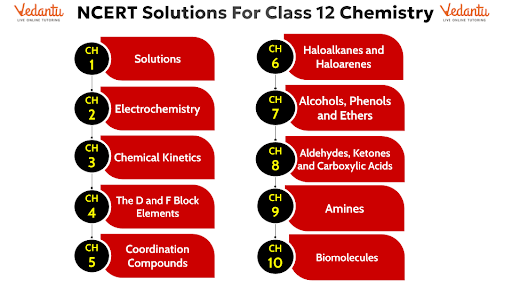Chapter-wise Class 12 Chemistry Questions and Answers Free PDF Download
FAQs on NCERT Solutions For Class 12 Chemistry All Chapters - 2025-26
1. Why are NCERT Solutions for Class 12 Chemistry essential for the 2025-26 board exams?
They are crucial because they provide step-by-step explanations for every question in the NCERT textbook, which forms the foundation for the CBSE board exams. These solutions are prepared according to the official CBSE 2025–26 syllabus, ensuring you learn the correct problem-solving methodology and cover all essential concepts required to score well.
2. How many chapters are covered in the latest Class 12 Chemistry NCERT Solutions for the 2025-26 syllabus?
The updated NCERT Solutions for Class 12 Chemistry for the academic year 2025-26 cover a total of 10 chapters. Chapters such as The Solid State, Surface Chemistry, and p-Block Elements have been removed from the latest syllabus, and the solutions reflect this revised structure.
3. What makes a good set of NCERT Solutions for Class 12 Chemistry?
A high-quality set of NCERT Solutions should have the following features:
- Accuracy: All solutions must be correct and verified by subject matter experts.
- Step-by-Step Format: Answers, especially for numericals and reactions, should be broken down into easy-to-follow steps.
- Syllabus Alignment: They must strictly follow the latest CBSE 2025–26 curriculum and guidelines.
- Clarity: The language should be simple, helping to build a strong conceptual understanding rather than just providing the final answer.
4. How can using NCERT Solutions improve my score in the Class 12 Chemistry board exam?
Using NCERT Solutions strategically can significantly boost your score. They help you master the prescribed methods for answering questions, which is crucial for getting full marks. By practising with these solutions, you can identify common mistakes, understand the expected format for answers, and strengthen your grasp on high-weightage topics like Electrochemistry, Chemical Kinetics, and Organic Chemistry.
5. How do the step-by-step methods in NCERT Solutions help in solving complex numerical problems in Physical Chemistry?
The step-by-step approach is vital for Physical Chemistry chapters like Solutions, Electrochemistry, and Chemical Kinetics. It helps in:
- Identifying the Formula: Clearly showing which formula (e.g., Nernst equation, Arrhenius equation) is applicable.
- Organising Data: Demonstrating how to list the given values and what needs to be calculated.
- Unit Conversion: Highlighting necessary unit conversions to avoid common errors.
- Logical Progression: Breaking down the calculation into logical parts, making it easier to follow and minimizing calculation mistakes.
6. Beyond finding correct answers, how can I use NCERT Solutions to understand the reaction mechanisms in Organic Chemistry?
To truly understand organic reaction mechanisms, use the solutions as a guide, not just an answer key. When you review a solution for a reaction (e.g., SN1, SN2, or an aldehyde reaction), focus on why a particular reagent was used, the role of the intermediate or transition state, and the factors determining the major product. The solutions help visualise the flow of electrons and the step-by-step transformation from reactant to product.
7. What is the correct way to use NCERT Solutions for self-assessment and identifying weak areas in Class 12 Chemistry?
For effective self-assessment, follow this method:
- First, attempt to solve all the in-text and exercise questions from a chapter without looking at the solutions.
- Next, compare your answers with the provided NCERT Solutions.
- For incorrect answers, don't just copy the solution. Instead, analyse the step where you went wrong to pinpoint conceptual gaps.
- Maintain a list of recurring mistakes to identify your weak topics for targeted revision.
8. Do the NCERT Solutions cover questions from both Part 1 and Part 2 of the Class 12 Chemistry textbook?
Yes, comprehensive NCERT Solutions cover all the chapters and their exercises from both Part 1 and Part 2 of the Class 12 Chemistry textbook, as prescribed by the CBSE 2025–26 syllabus. This includes solutions for all in-text questions, examples, and end-of-chapter exercises for chapters ranging from 'Solutions' to 'Biomolecules'.
9. Should I refer to NCERT Solutions immediately after attempting a question, or is there a better approach?
The most effective approach is to avoid looking at the solutions immediately. First, genuinely attempt the problem on your own. Spend time trying to recall the concept or formula. Only after making a sincere effort should you consult the solution. This practice builds critical thinking and problem-solving skills, whereas immediately checking the answer promotes dependency and hinders learning.
10. Are the provided NCERT Solutions for Class 12 Chemistry aligned with the latest CBSE marking scheme?
Yes, reliable NCERT Solutions are designed to be in complete alignment with the latest CBSE 2025–26 marking scheme and guidelines. The answers are structured to include all necessary steps, keywords, and chemical equations that examiners look for, helping you learn how to write answers that fetch maximum marks in the board examination.


























